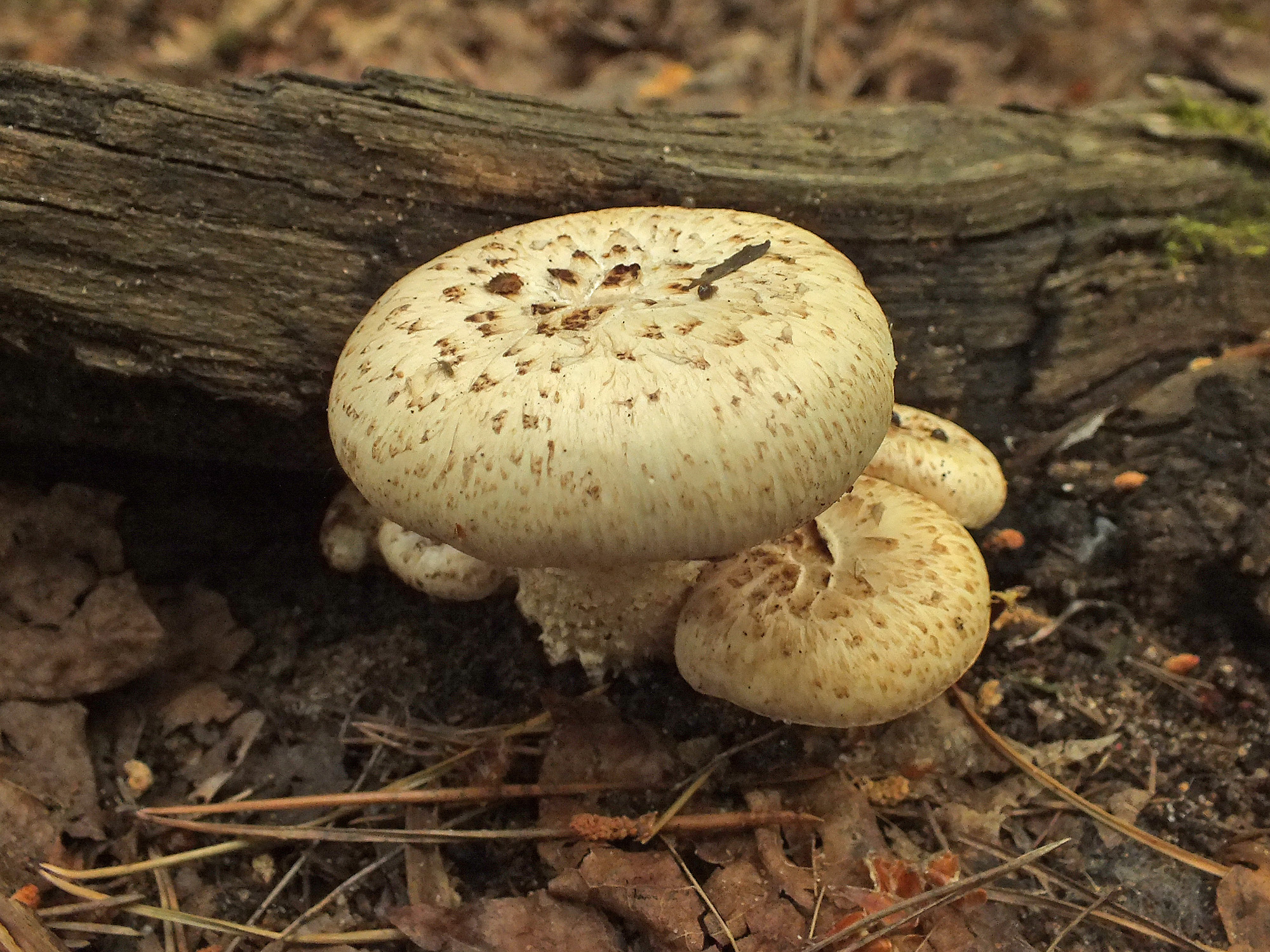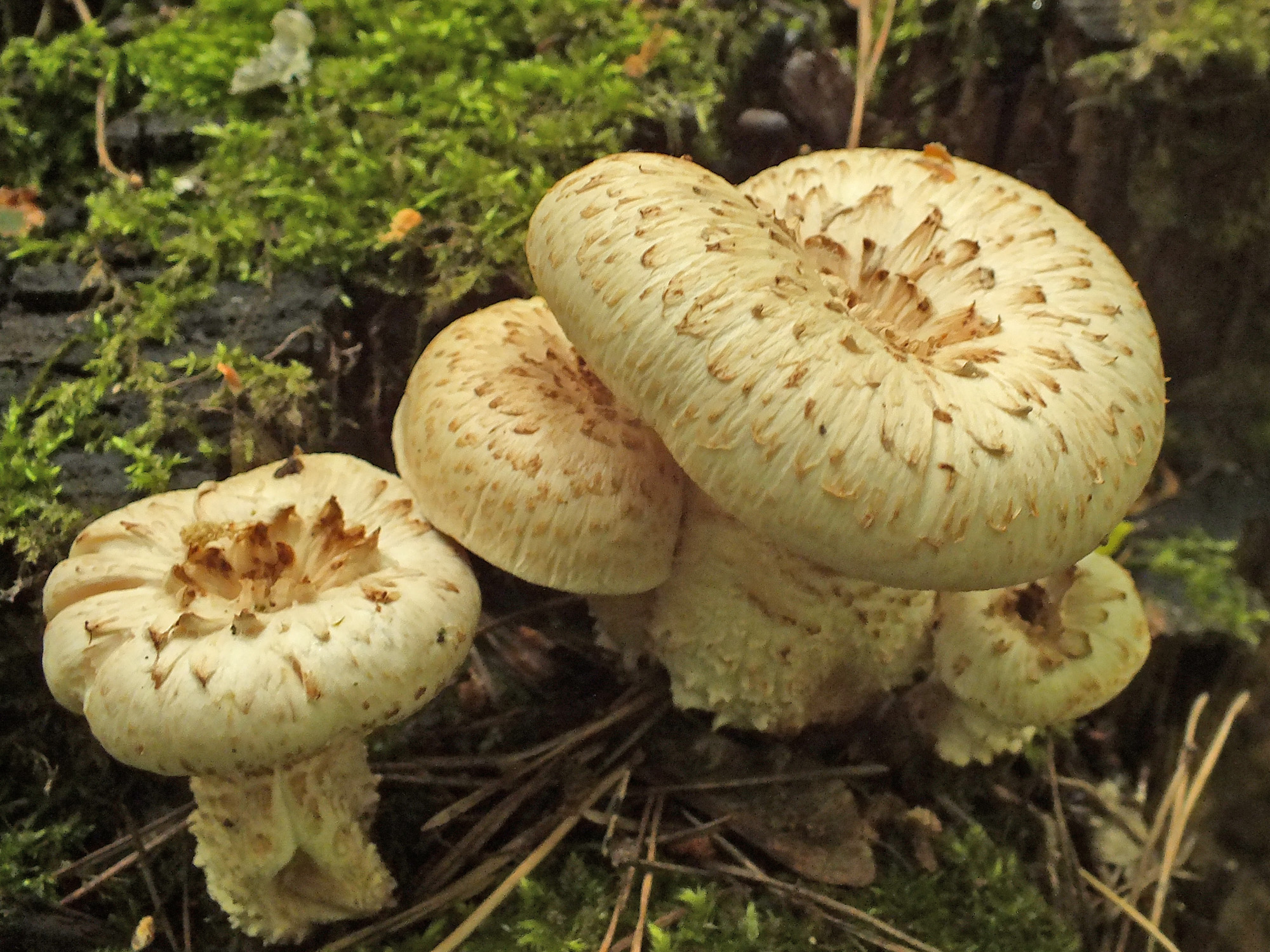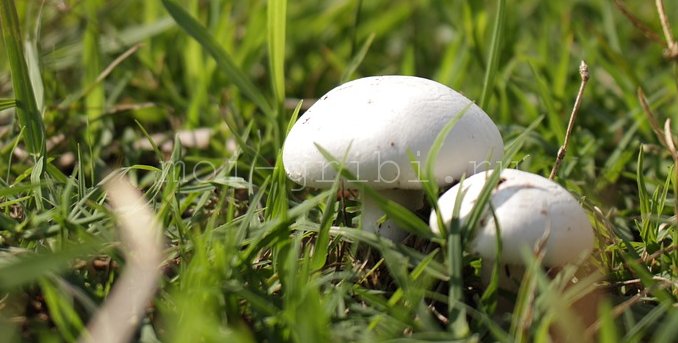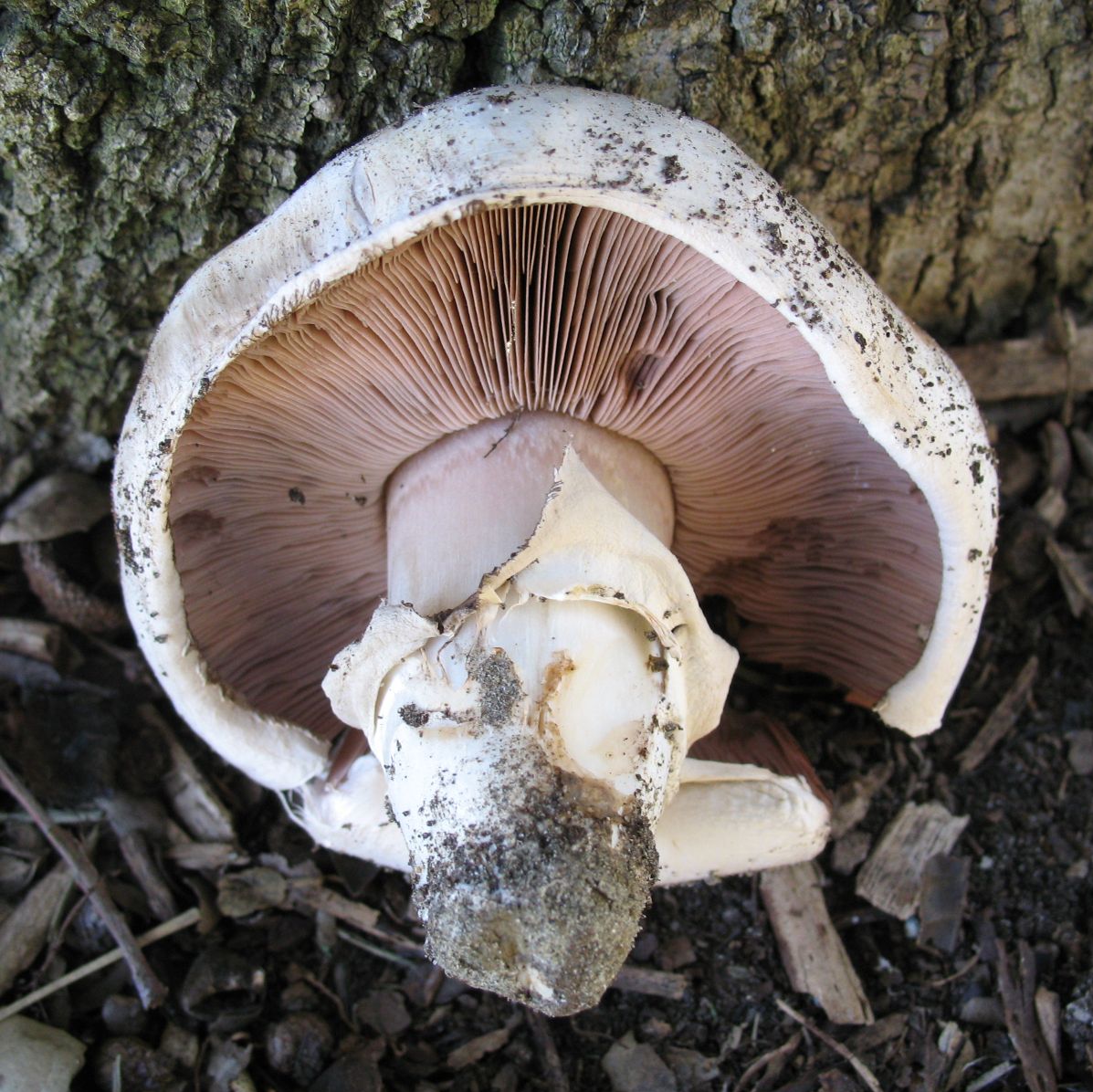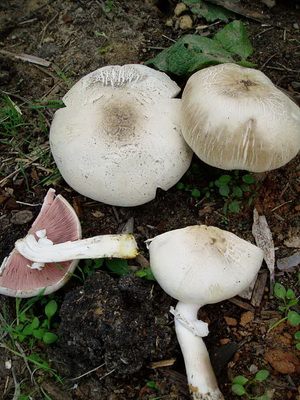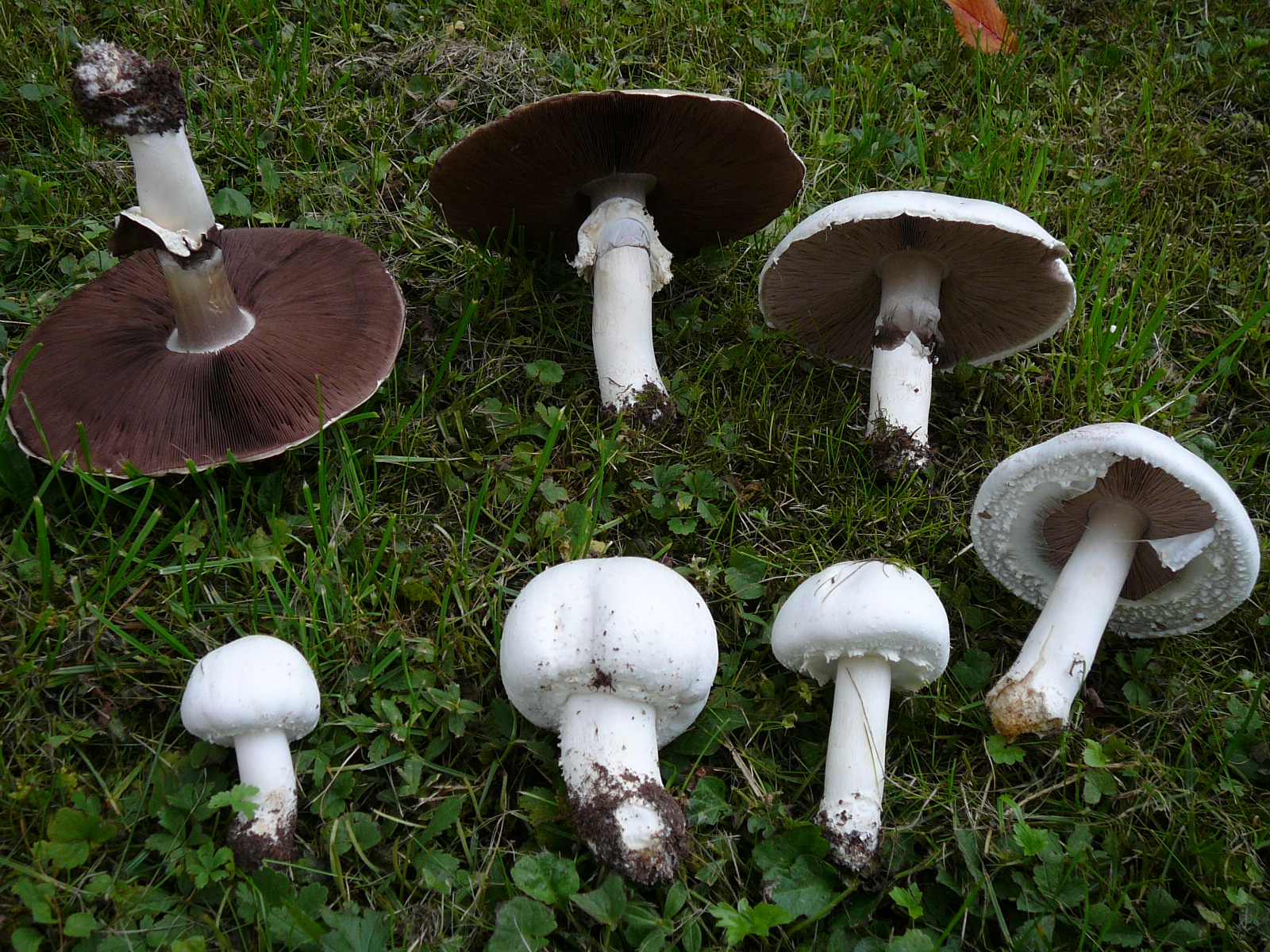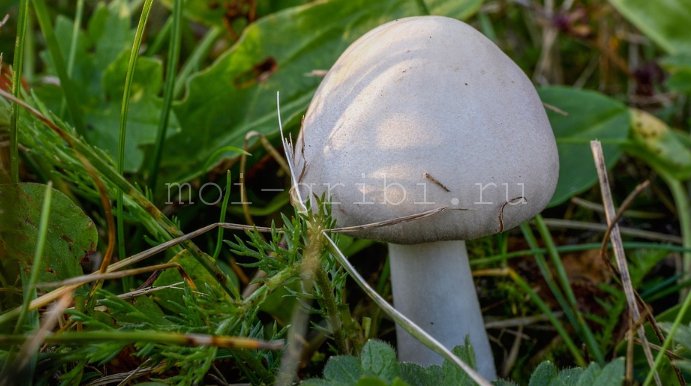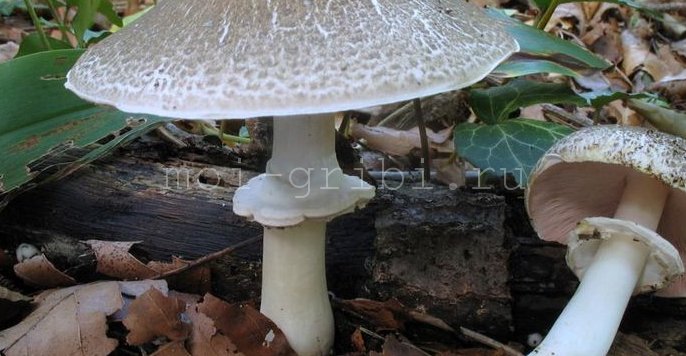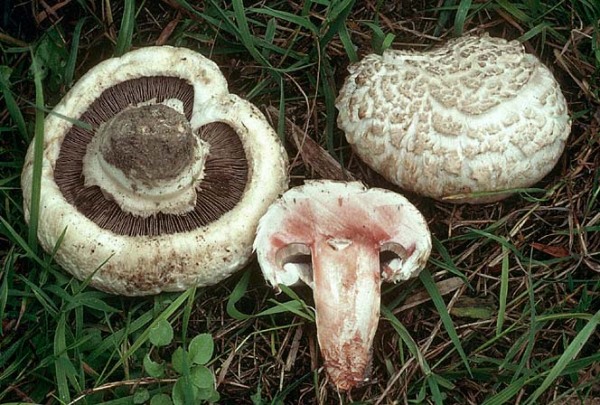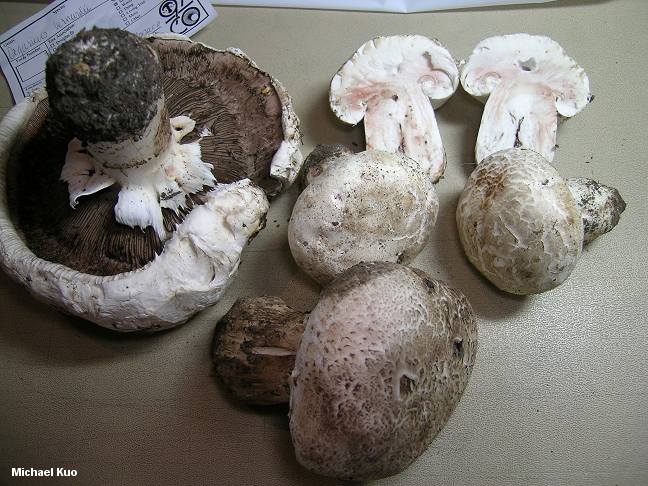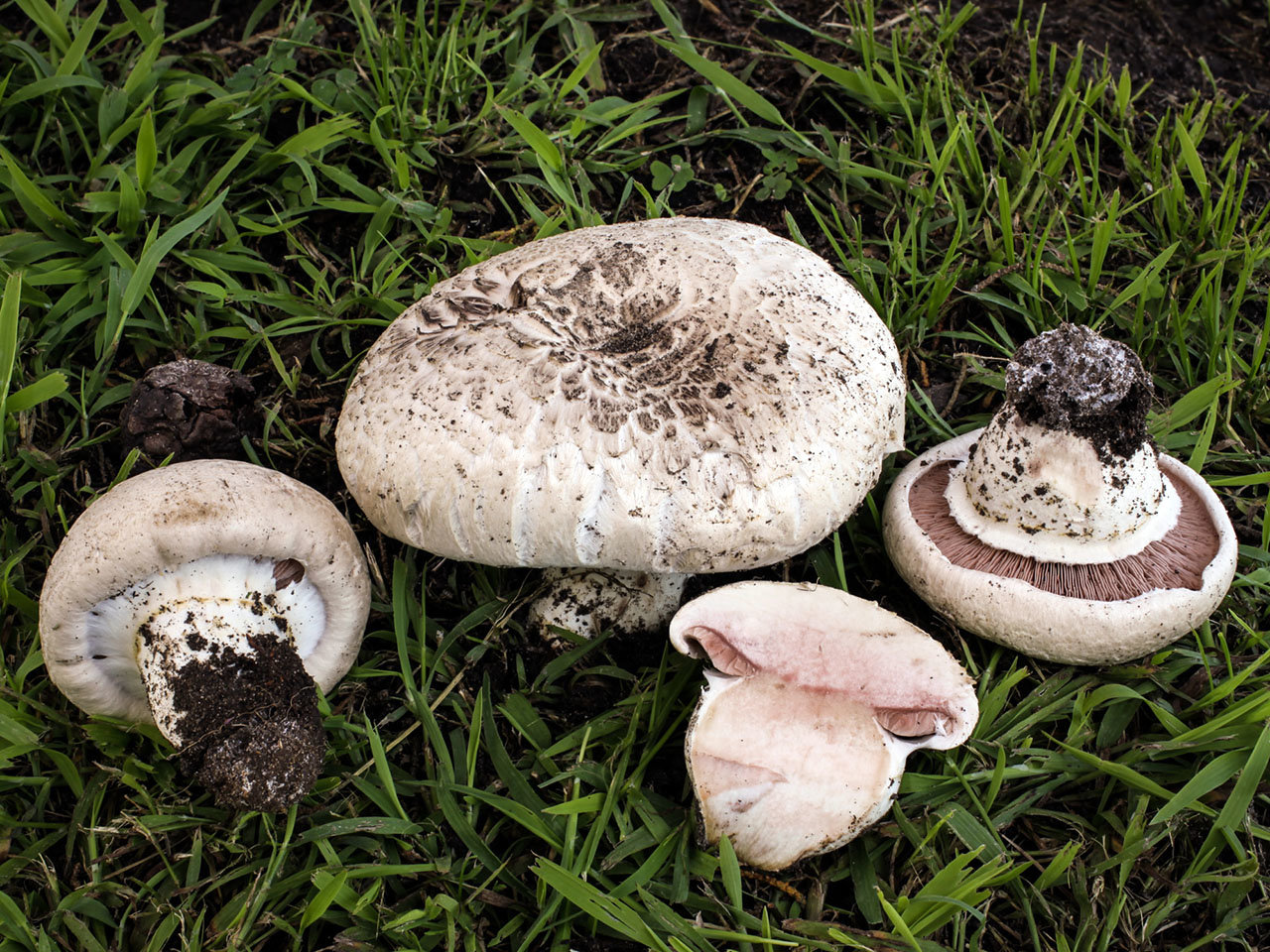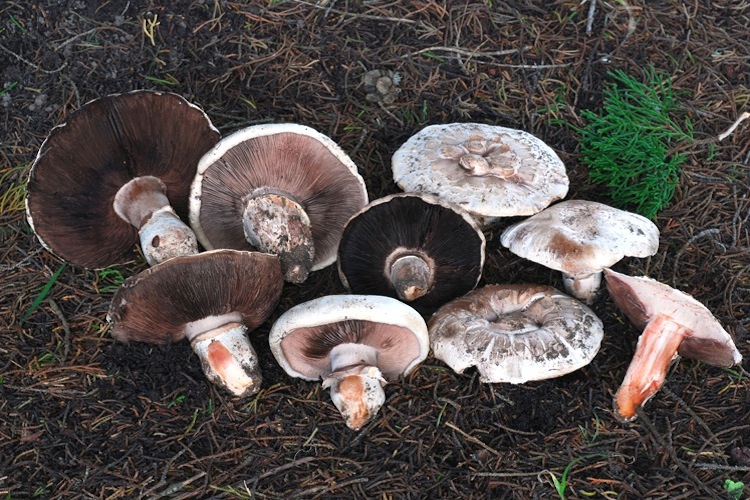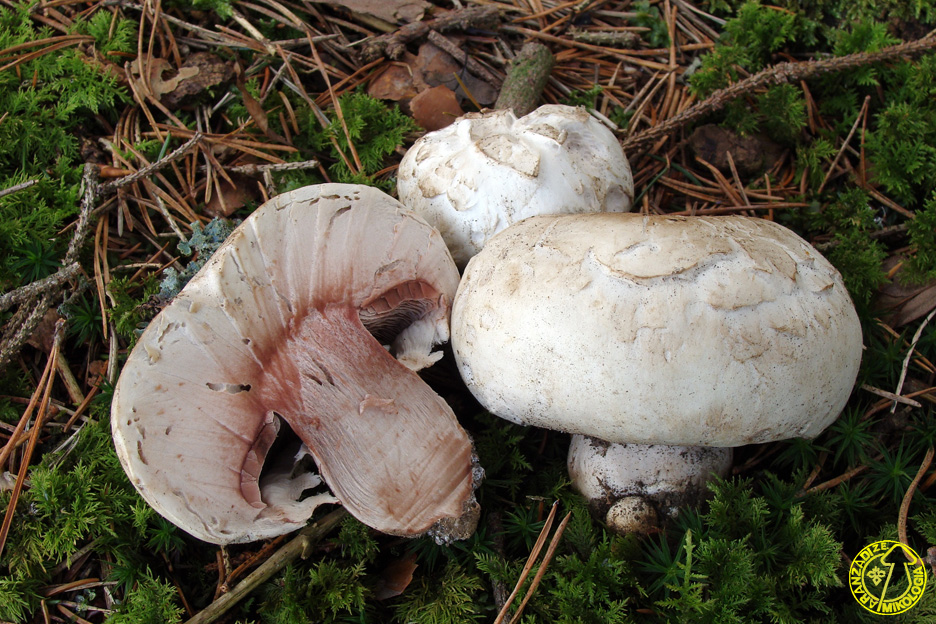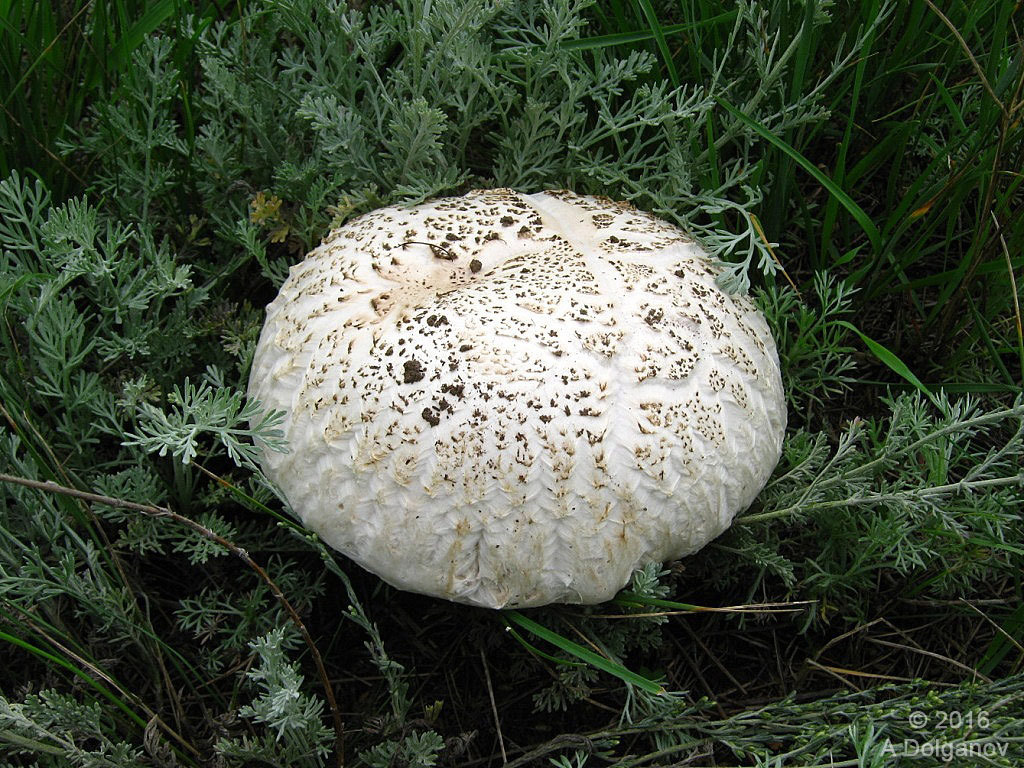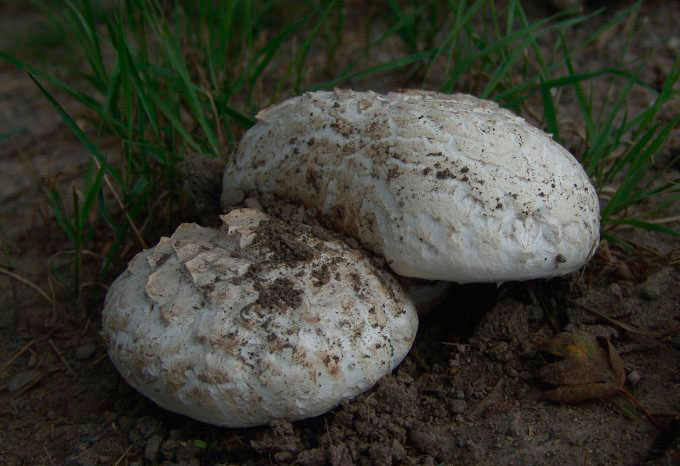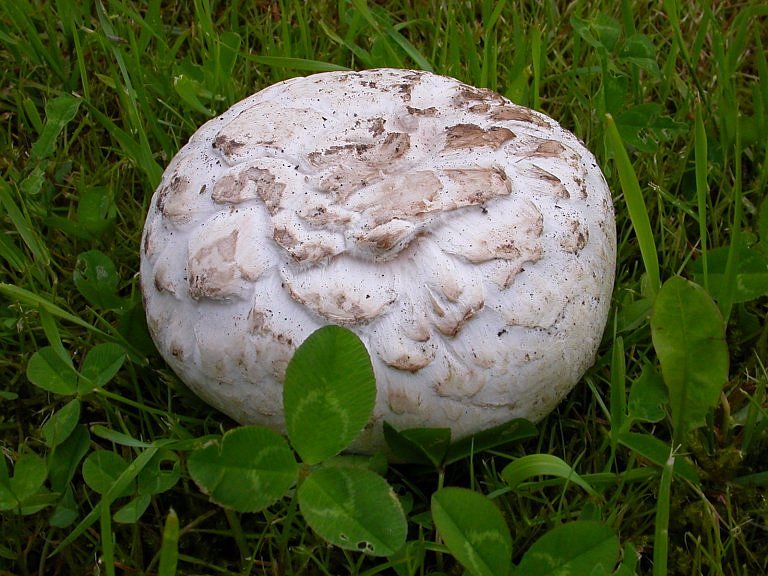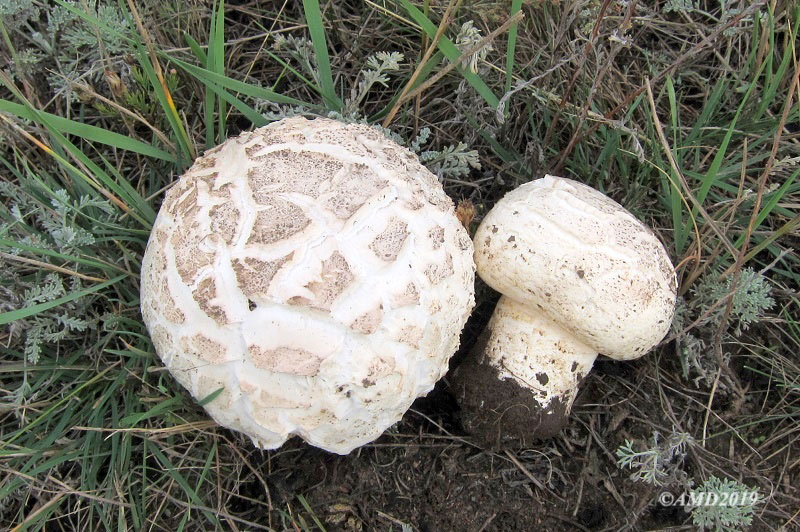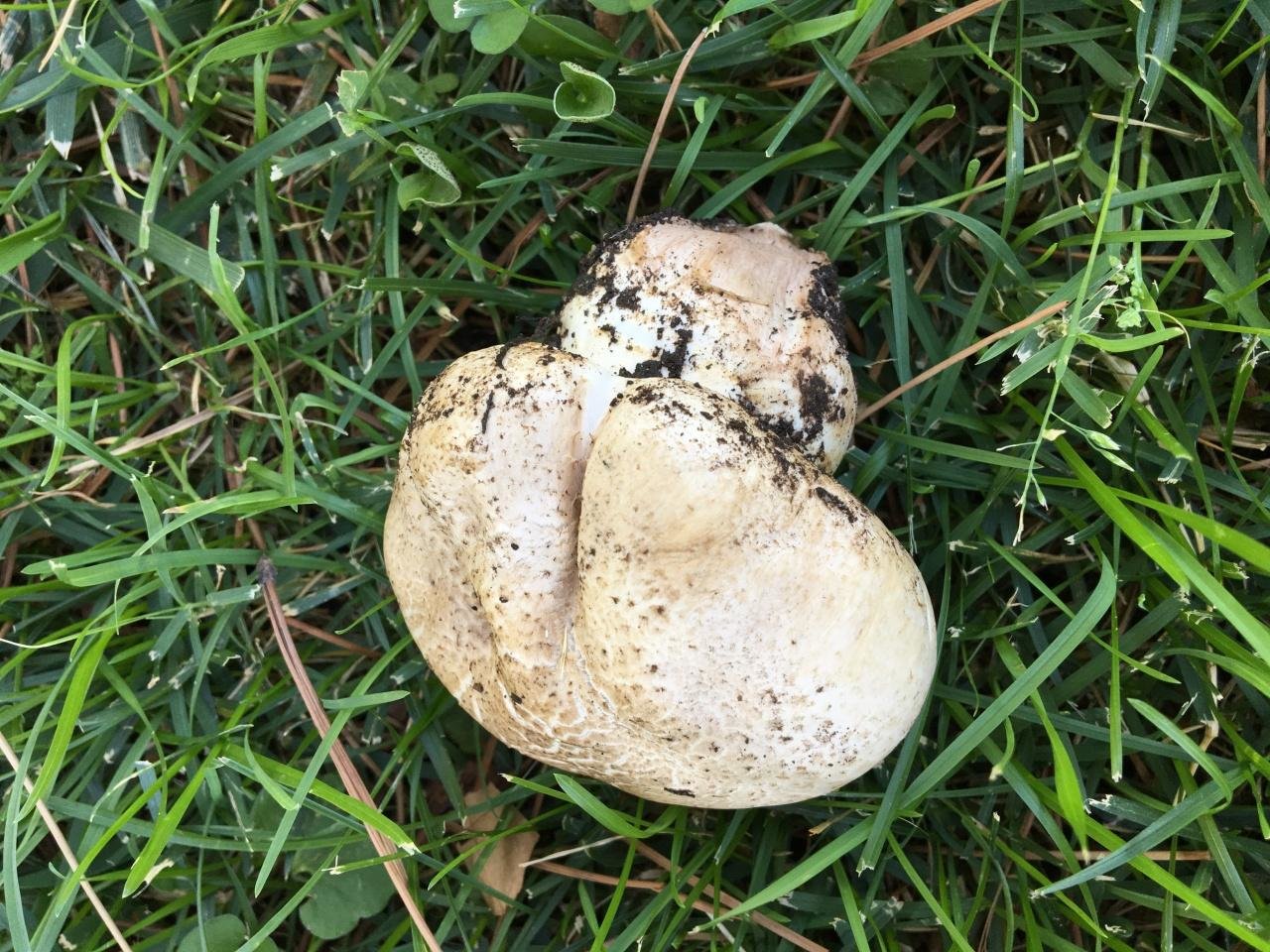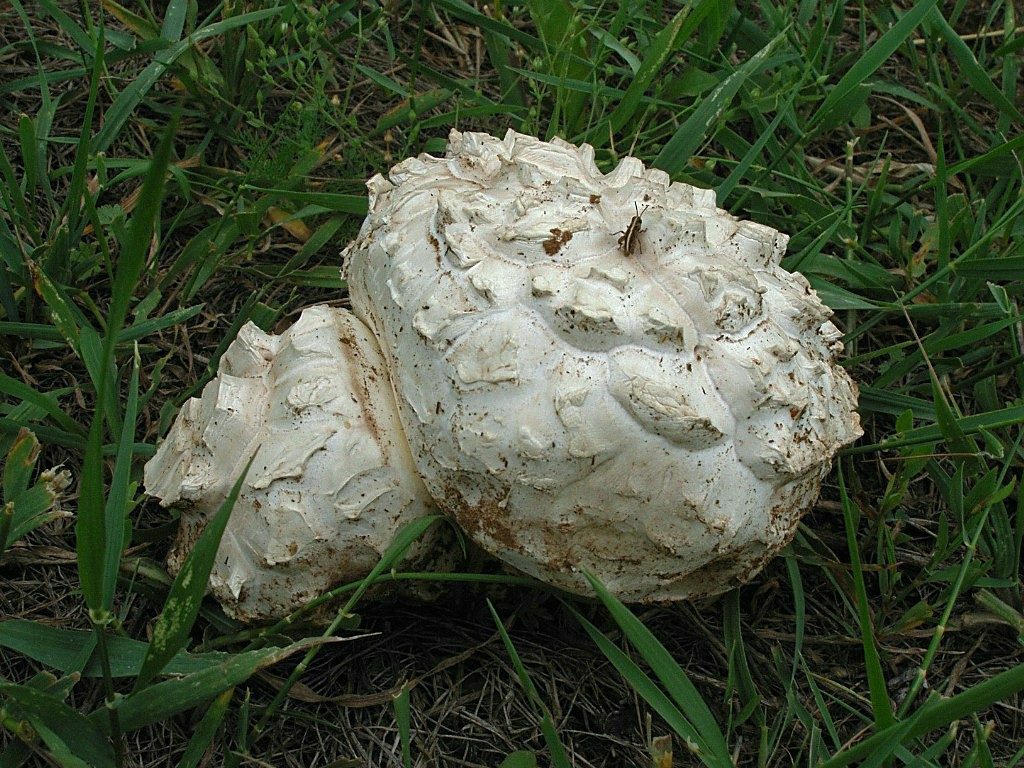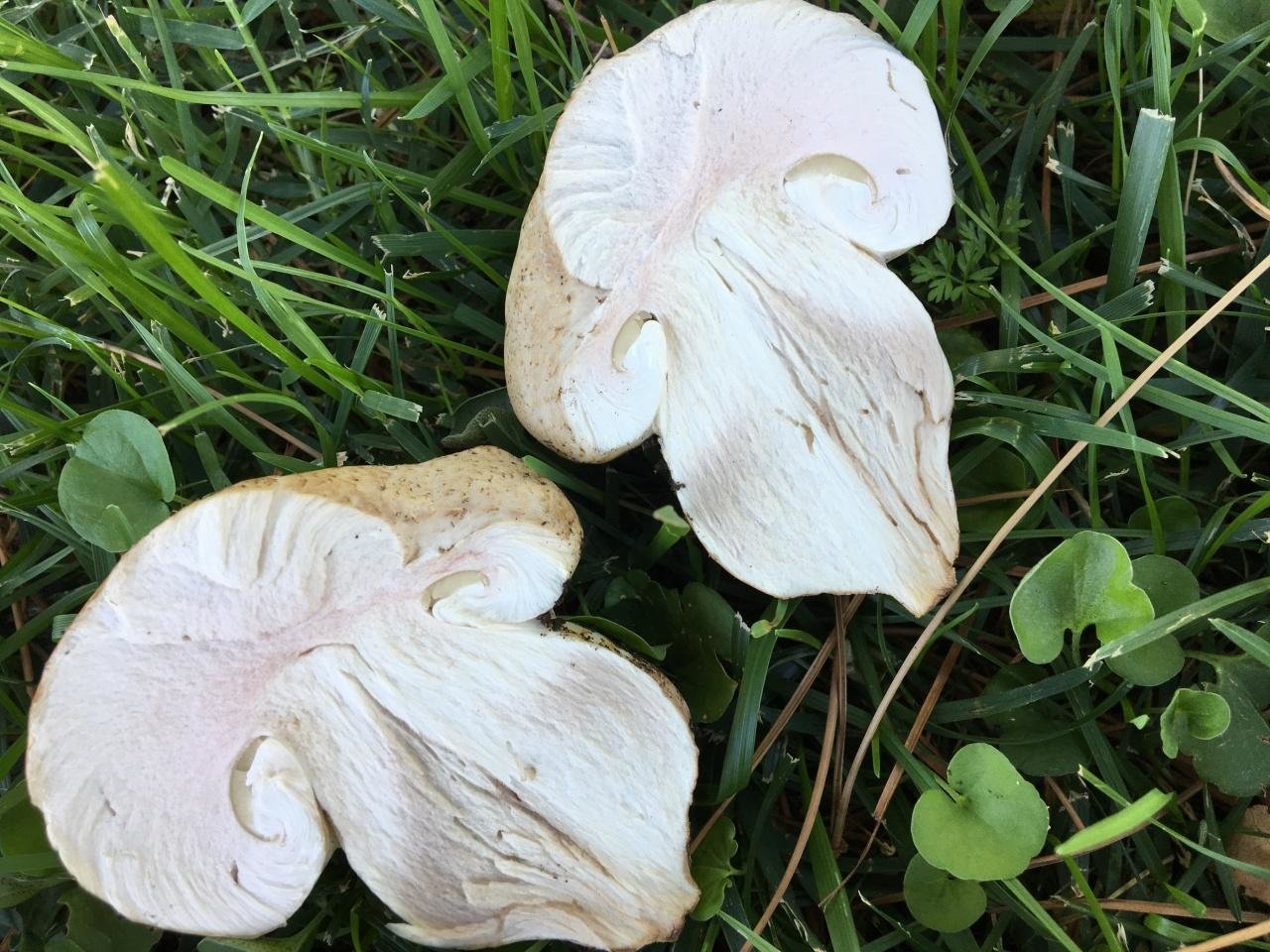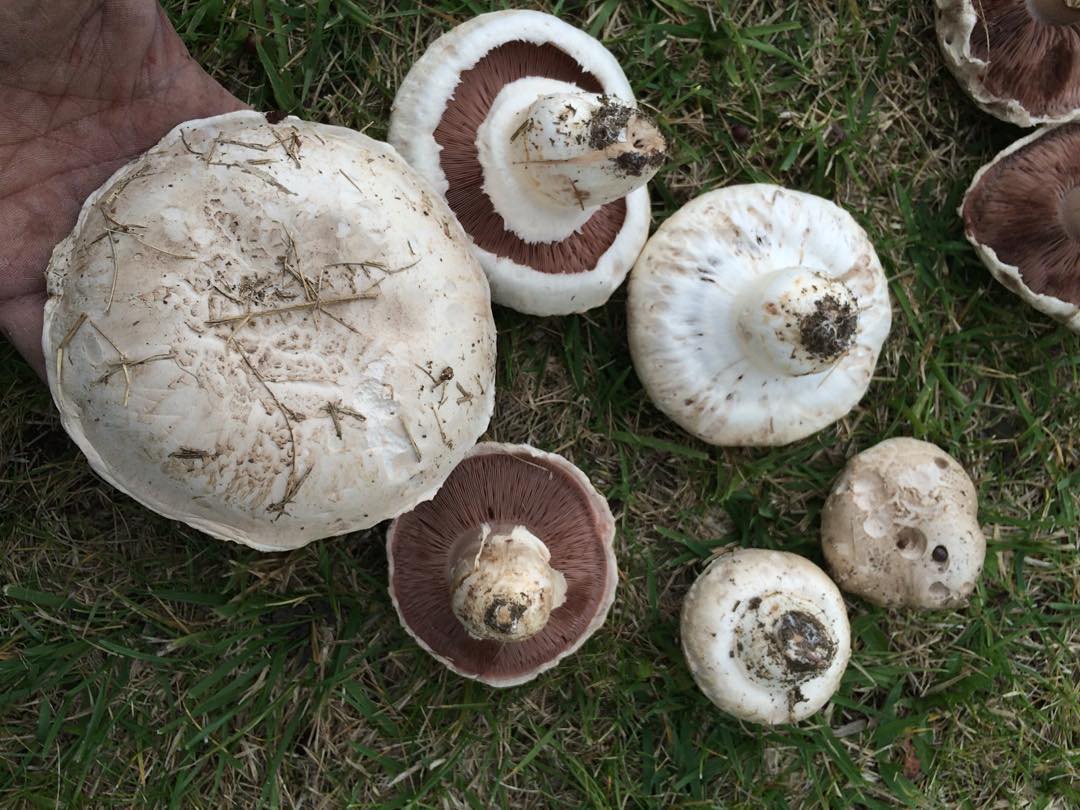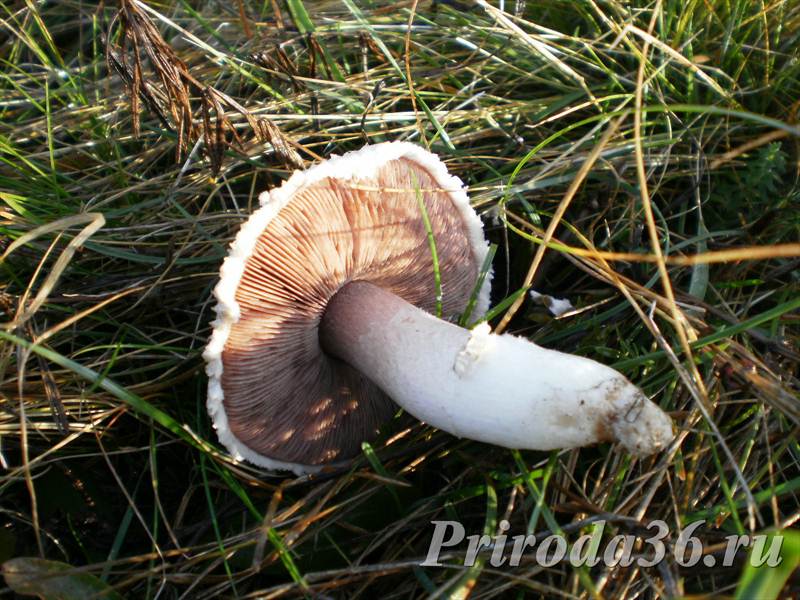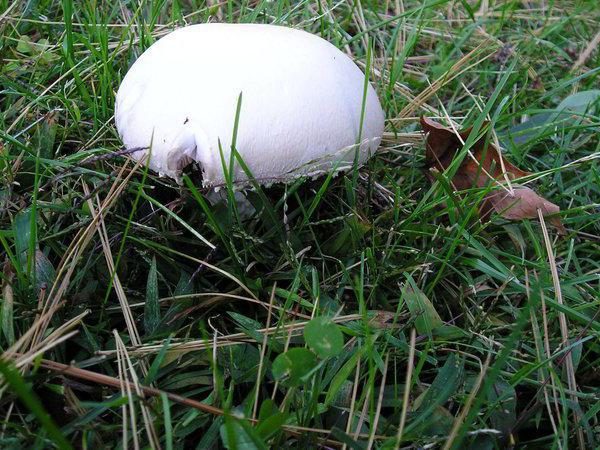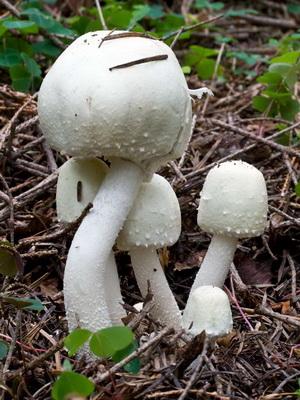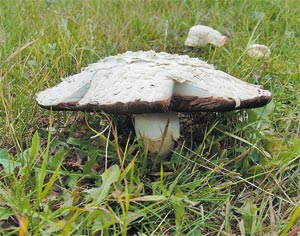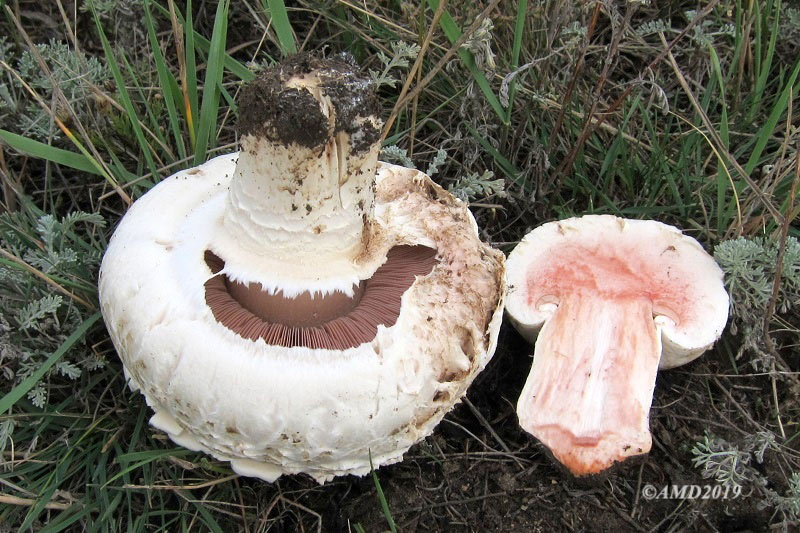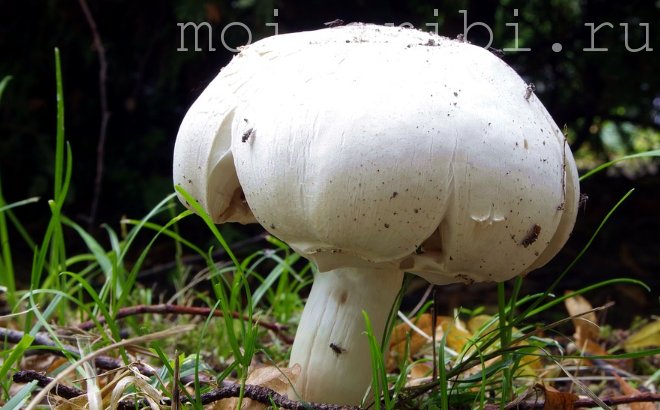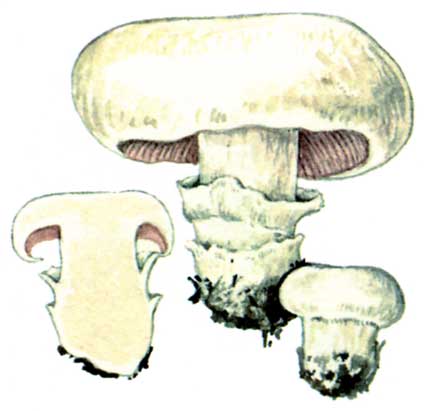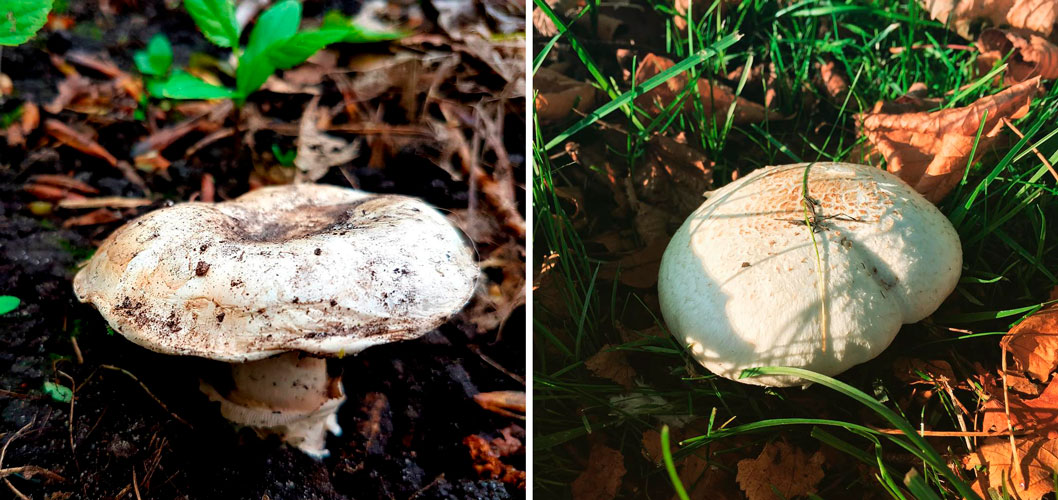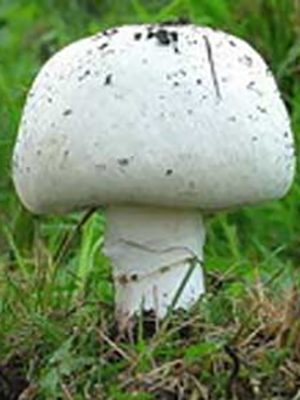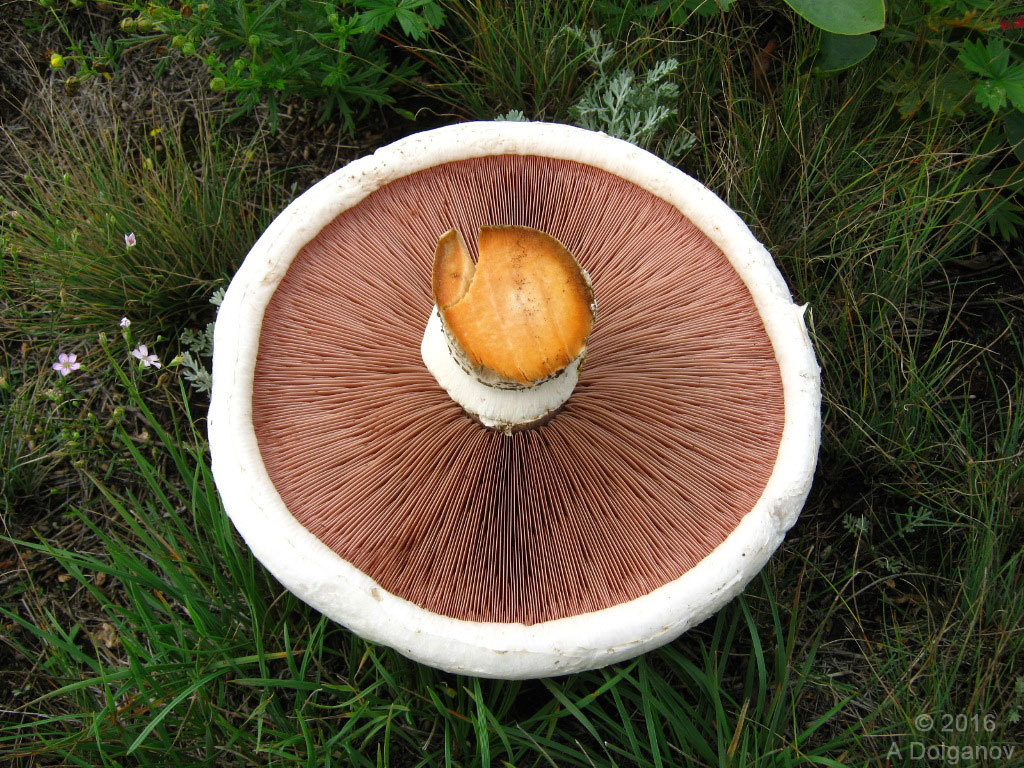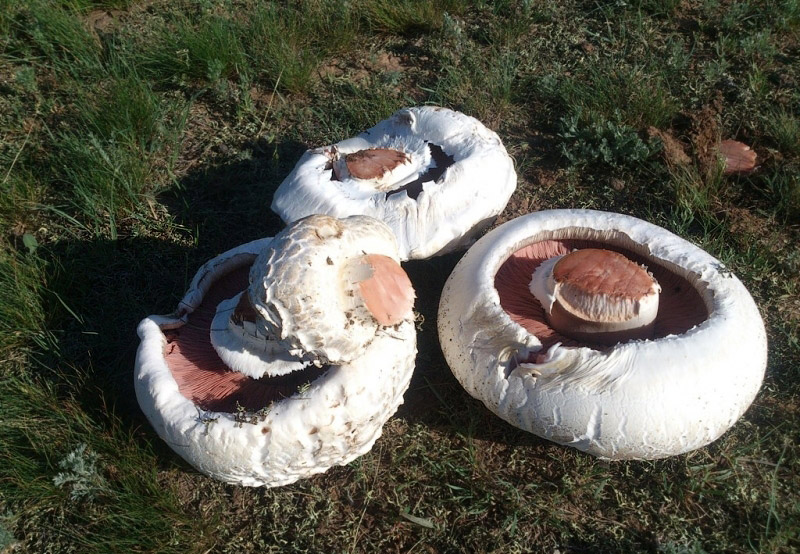Champignon august

Champignon august (lat.Agaricus augustus)
Of all types of champignons, this is the largest mushroom. It got its name from the timing of its appearance and maturation. You can find it from mid-August to the end of September, mid-October. His favorite habitats are coniferous and deciduous forests. It is not uncommon to be found near anthills or directly on them. Grows in groups. But this is not a common mushroom. It is not so common.
An easily recognizable mushroom. The cap is light yellow with brown scales. Unlike its counterpart in the forest mushroom family, which it looks like, the August mushroom has a brownish brown rather than golden cap base.
The hat is quite large, up to 15cm in diameter. It can reach 20 cm. It is dark orange or dark brown in color. Thin. Young mushrooms have a closed, hemispherical cap. With age, the cap becomes open. The edges of the cap are bordered by a large, hanging blanket. A distinctive feature of this mushroom is the brown scales that cover the cap.
The plates are bristling, free. With age, they change color from pale pink in youth to brownish-black in old age.
The leg is long and strong. Hollow inside. Covered with flaky yellow-brown scales. On the leg, a large hanging, folded ring is clearly visible, under which scales are also located. The color is whitish yellow.
The flesh of the August champignon has a pleasant, almond smell, fleshy. On the cut, the color changes from yellow to brown.
Like all mushrooms of this species, it is rich in phosphorus and potassium, vitamins A, B, C, PP, which have a detrimental effect on typhoid pathogens.
Champignon august belongs to the third category of mushrooms in terms of its nutritional value. Very tasty. It is usually consumed fresh, but it is also suitable for pickling and drying.
But you should not abuse it because of the ability to accumulate in the body such a harmful substance as cadmium.
Large-spore champignon
Large-spore champignon (lat. Agaricus macrosporus)
This is a fairly common mushroom. The habitats of this type of champignon are quite diverse. It can be found in almost all European countries. It also grows in England, Asia, the republics of the Caucasus. Large-spore champignon grows mainly on meadow soils rich in organic matter. The mushroom is large.
The hat is convex, white. At a young age, fibrous, eventually cracks into wide plates or scales. The edges of the cap become velvety as the mushroom matures. Reaches 25 cm in diameter. At a break it is white, after a short time it turns red.
The plates of the large-spore champignon are free. They are located very often. At an early age, pale pink or gray. Over time, the plates turn brown.
The leg is full, dense. It reaches a height of 6-10 cm. At the base it is thickened. It can be white or off-white. Fusiform, sometimes covered with flakes. It bears a single thick ring, which is covered with scales on the underside. The pulp is white, slightly reddens over time. An adult mushroom has the smell of almonds on the cut, turning into the smell of ammonia.
The large-spore champignon in its nutritional value belongs to the mushrooms of the first category, which indicates its beneficial properties for the healing and treatment of our body. Possesses good taste.
Types of meadow champignon
Those who do not like to delve into the thickets of the forest, the meadow mushroom is of particular interest. It grows in open meadows, garden and summer cottages, near houses and farms - in general, where we most often go by the nature of our activity or place of residence.
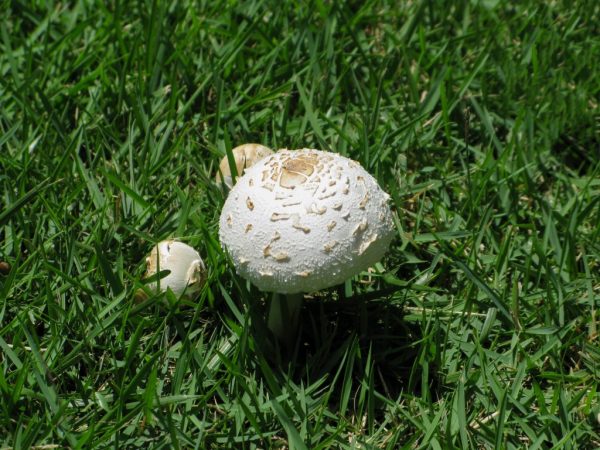
Types of meadow champignon
Description
The word "Champignon", translated from French means "mushroom".
- diameter - from 7 to 17 cm;
- shape - regular, rounded, with a characteristic bulge;
- the color is gray-brown;
- membranes (hymenophore plates) are thin, transparent, densely spaced;
- spores are gray-black.
- height - 9-11 cm;
- diameter about 2 cm;
- shape - cylinder;
- the ring is thin-membranous.
- the structure is dense;
- White color;
- the smell characteristic of champignon.
Changes during growth
In the process of intensive growth, the leg quickly thickens, the structure becomes denser, the upper skin acquires a pinkish or yellowish tint.
The hat becomes rough and hard when it reaches biological maturity. The plates gradually acquire a reddish-brown color.
The meadow mushroom never grows alone - its biology excludes this. It forms groups in the form of rings, which are also called "bracelet of the forest" or "witch's rings". Human-cultivated lands are the most suitable habitat for ovens (popular name for meadows)
Agaricus campestris, or field mushroom, has relatives that grow in similar natural conditions. These include:
- NS. ordinary;
- NS. Bernard;
- NS. two-ring.
In order for the harvested crop to bring only benefits, before going into the forest, it is important to find out which species are poisonous and how to distinguish them from edible ones. Young champignon is often confused with pale toadstool or white amanita, which really look like this mushroom.
Only meadow grass has pinkish plates, and poisonous porcini mushrooms
Young champignon is often confused with pale toadstool or white amanita, which really look like this mushroom. Only meadow has pinkish plates, and poisonous porcini mushrooms.
Field champignon
Agaricus arvensis (wild meadow mushroom) is an edible species used in industrial culinary applications.
- diameter - 16-20 cm;
- color white-gray or cream;
- membranes (plates) are thin, densely spaced;
- the form in the period of technical ripeness is egg-like, in the period of biological ripeness it is bell-shaped.
For your information. The technical ripeness of a mushroom or agricultural plant means that they have reached a certain size, which allows them to be harvested.
- height - 8-11 cm;
- diameter - 1-1.5 cm;
- the ring is two-layer.
- color white or yellow;
- the structure is loose.
In young specimens, the caps are characterized by the presence of curved edges. Then they become wavy and cracked. When pressed, the leg turns yellow, as does the pulp at the break. It tastes sweet and aromatic.
The species has poisonous counterparts. It is confused with pale toadstool and yellow-skinned champignon. The difference is in the smell: poisonous smells like a medicinal mixture.
Field champignon is widespread in the north of Russia, bears fruit from May to November in fields and pastures, in nettles and at the bases of spruces.
In England it is called "horse mushroom" because it is often found in manure.
Forest mushroom
Forest mushroom (lat. Agaricus silvaticus)
Popularly referred to as a wolf mushroom. Also known as blagushka and cap.
It is less popular with mushroom pickers because of its reddening pulp. It can be eaten in all forms, even raw. It got its name because of its "residence". It has a pleasant smell and excellent taste. It grows mainly in spruce and coniferous forests. Less common in mixed forests. It prefers to grow near anthills and, in frequent cases, at their very top.
The leg is straight or curved. In young mushrooms, it is whole, becoming hollow over time. The thickening in the lower part of the leg becomes thin closer to the cap. Height 5-10 cm. The color of the leg is dirty gray. It has a thin ring at the top. During the ripening process, the ring disappears.
The cap of the young forest mushroom is ovate-bell-shaped, the color varies from light gray to brown-brown in maturity. At this age, the cap takes on a prostrate shape. The size of the cap is 5-10 cm, often up to 15. The cap is covered with large brown scales.The pulp, unlike most champignon mushrooms, is rather thin and light. When cut, it turns red.
Champignon
Photo of Champignons from Woodmen19 (Yandex.Photos)
Champignons - this mushroom is not a gimmick, it turns out to be great to grow in large quantities in special greenhouses, there are even different varieties of Champignons that differ in taste, fertility and cap color: brown, cream and white.
But Champignon also has wild cousins that grow in the wild and have a much brighter taste and aroma: wild Champignon grows in open meadows, meadows, it can often be found in pastures where cows are grazed and the soil is abundantly fertilized with manure. Slightly less often, Champignon can be found in sparsely planted mixed forests, where the sun's rays can reach the forest floor.
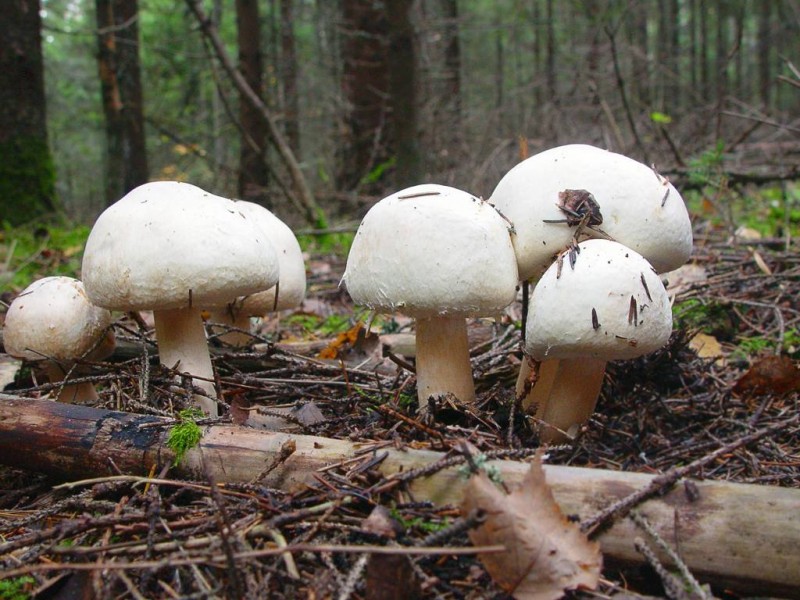
Champignon name
The Russian name for the mushroom Champignon comes from the French word champignon, which simply means "mushroom".
The people also call champignon a bell, a cap.
Where does Champignon grow?
Wild Champignon grows in open meadows, meadows, it can often be found in pastures where cows are grazed and the soil is abundantly fertilized with manure. Slightly less often, Champignon can be found in sparsely planted mixed forests, where the sun's rays can reach the forest floor. At times, Champignon can be seen in the garden or even in the city.
What does Champignon look like?

A characteristic feature of the Champignon is the pink bottom of the hat (plate), covered with a thin white skirt. As the mushroom grows and matures, the cap opens, and the pink color of the plates begins to darken. in old champignons, it becomes coal-black, and in very young mushrooms, pale pink - by this sign, you can unmistakably choose mushrooms in the store.
How to distinguish champignons?
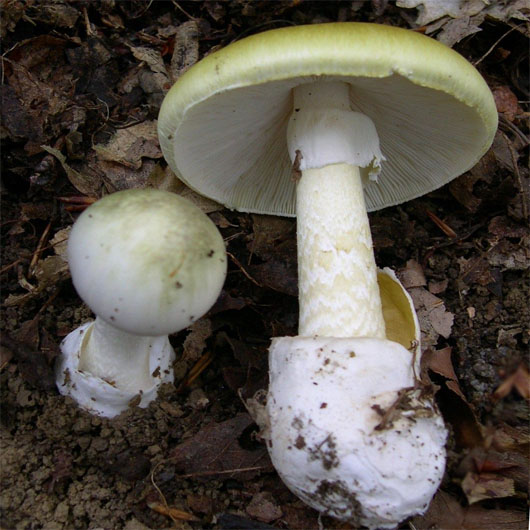
Young wild mushrooms must be distinguished from the Pale Toadstool (a very poisonous mushroom). How to distinguish Champignon from Pale toadstool?
1. The color of the plates differs: in champignons - from pink in young to brown in old ones, in pale toadstool - always white.
2. The base of the foot of the Pale Toadstool is framed by a film, like a fence.
Why is Champignon useful?
The calorie content of Champignons is 27 kcal per 100 grams.
Champignon contains valuable proteins, carbohydrates, organic acids, minerals and vitamins: PP (nicotinic acid), E, D, B vitamins, iron, phosphorus, potassium and zinc, useful for the body's immune system. In terms of phosphorus content, champignons can compete with fish products.
How to store Champignons?
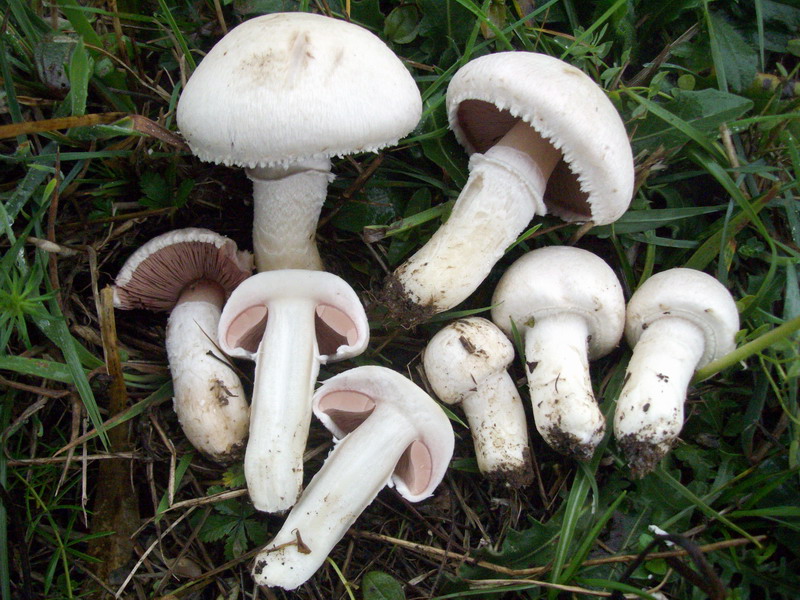
Champignon is a universal mushroom - you can eat it in any form, it is excellent for drying for the winter and for rolling into jars and for preparing first and second courses.
How to cook Champignons?
Before cooking Champignons, they should be thoroughly cleaned. Mushrooms can be cleaned of soil and dirt with a knife, then quickly rinsed under running cold water, but do not soak - Champignons will absorb water, become tasteless and watery.
Champignons are fried for no more than 20 minutes (total time) until golden brown.
Champignon dark red
Champignon dark red (Latin Agaricus haemorroidarius)
Champignon dark red (lat.Agaricushaemorroidarius)
This type of champignon usually grows in deciduous forests. It is rare. Grows in small groups. It can be found under fallen branches and trees. Ripening season - mid-summer, autumn (June to October).
The mushroom is relatively large. The cap reaches 10-12 cm in diameter. At an early age, bell-shaped, with a blunt apex. Over time, it opens up and becomes prostrate. The color of the cap is brown-brown.
In adulthood, the skin cracks and turns into fibrous scales. The pulp has a soft taste, white color. At the break, it quickly turns red. Has a mild sour smell.
The plates are frequent, loose, light pink in young mushrooms and brown-black in old age. A characteristic feature is that when touched, the plates turn red.
The stem of the mushroom is off-white, hollow. Reaches 8-10 cm in height. Thickening is noticeable at the base.Bears on itself a wide, freely hanging ring, brown. Below the ring, the leg is scaly. Just like the cap and the plates, the leg of the dark red champignon quickly turns red when pressed or broken.
The dark red champignon is an edible mushroom. Has a mild taste.
Not cultivated on an industrial scale. It is used in food in almost any form. It can be marinated, stewed, fried, dried.
External description
The fruit body of a half-shod champignon consists of a stem and a cap. The diameter of the cap varies between 5-15 cm, and it itself is very convex, fleshy, with dense pulp. In mature mushrooms, it becomes convex-outstretched, even depressed in the central part. The color of the cap of the described species can be yellowish, light brown, or simply brown. Its surface is densely covered with reddish-brown or brown scales. At the edges of the cap, you can see the remnants of a private bedspread in the form of small film scales. At high levels of humidity, the surface of the cap becomes slightly sticky.
The hymenophore of half-shod champignons is lamellar, and the plates in it are often located, but freely. They are very narrow, in young mushrooms they have a pale pink tint, later acquire a meaty color, even turn brown and dark brown, almost black.
The length of the stem of the mushroom varies in the range of 4-10 cm, and its diameter reaches 1.5-3 cm. It comes from the inner central part of the cap, is characterized by a cylindrical shape and great thickness. Inside, it is executed, often just straight, but sometimes it can slightly expand near the base. The color of the stem of the mushroom can be whitish-pink, pink-gray, and, if damaged, acquires a reddish-brown tint. Above the periapical ring, the surface of the leg of the half-shod champignon is completely smooth, but in some specimens it may be slightly fibrous.
Under the ring on the leg, one can see the brownish belts of the volva, which are located a short distance from each other. The surface of the leg may be covered with small scales, sometimes with a baggy light brown volva.
The pulp of the half-shod champignon (Agaricus subperonatus) is characterized by a high density, ranging in color from pale brown to rusty brown. At the stem and cap at the junction, the flesh becomes reddish, does not have a pronounced odor. Some sources indicate that in young fruiting bodies of the described type of champignons, a fruity aroma is slightly noticeable, and in ripe mushrooms, the aroma becomes more unpleasant, and resembles the smell of chicory.
The peri-head ring is characterized by a large thickness, white-brown color, double. Its lower part grows together with the leg. Fungal spores have an ellipsoidal shape, a smooth surface and dimensions of 4-6 * 7-8 cm. The color of the spore powder is brown.
Poisonous types of champignons
Not all the fruits of the family we are considering can be eaten, so every potential gatherer should know how the poisonous mushrooms, beloved by everyone, look like
Pay attention to the description of dangerous mushrooms, as they are also often found in the wild:
Yellow-skinned (Agaricus xanthodermus)
It looks like a field fellow, only the leg is yellowish-orange. The damaged skin or pulp also acquires a yellow tint, exudes a nasty smell, reminiscent of carbolic acid.
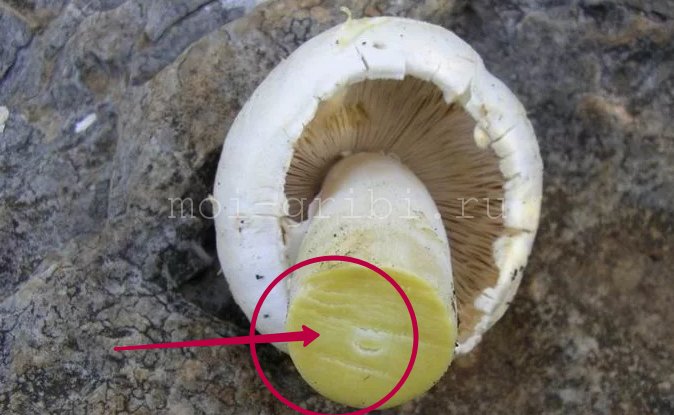
He's ginger
It has a medium-sized head, widening at the edges, the surface is covered with small scales. If you press on the pulp with your fingernail, it instantly turns yellow. The stem is thin, often empty inside, bordered by a small fibrous rim. On the inner side of the cap there are thin, frequent plates of light shades (can be beige or pink); during aging, the plates darken and become brown-brown. You can distinguish a mushroom from an edible one both visually and by its smell, which can hardly be called pleasant.It happened that people consumed several fruits of the red-colored champignon - there was no lethal outcome, but unpleasant poisoning could not be avoided.
Motley (Agaricus meleagris)
Other names are carbolic, flat, scaly. By the appearance of the fruit, it is easy to determine which mushroom is in front of you - a gray cap with a darkened core also exudes the smell of carbolic acid. Folk healers and experienced old women argue that this variety is suitable for eating if the deceptive forest gift is thermally processed at least five times, but it is better not to risk your own health.
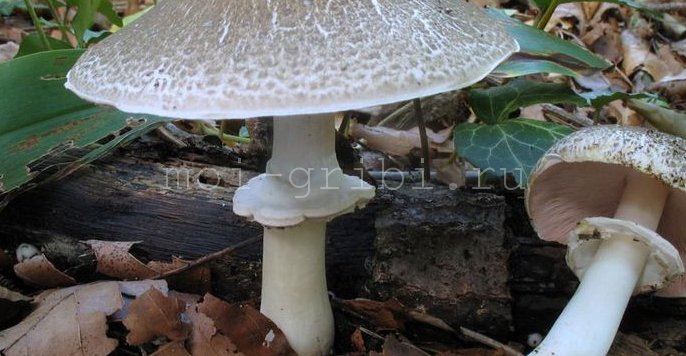
We have considered the most common types of champignons, since they are most often found by numerous gatherers. Do not be afraid to go for the forest harvest, improve your knowledge and remember the golden rule of any forester - “Doubt? Do not take".
Field champignon: description of appearance and photo
Category: edible.
In 1762, the field champignon (Agaricus arvensis) was singled out into a separate group by the professor of the Wittenberg and Tübingen Universities, Jacob Scheffer, a botanist, ornithologist and entomologist.
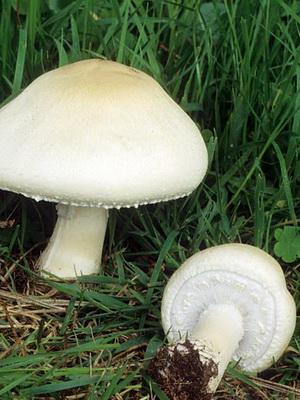
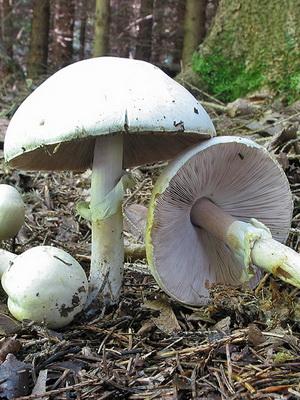
In appearance, the field mushroom is slightly different from other species. Hat (diameter 7-22 cm): white, gray, cream or light ocher (in old mushrooms) with remnants of the coverlet. It has the shape of a small egg or bell, but over time becomes almost prostrate with a noticeable tubercle in the center. The edges of young mushrooms are wrapped inward, and later become wavy. In dry weather, they can severely crack, due to which they become uneven and torn. Smooth to the touch, in rare cases it may have small scales. Stem (height 5-12 cm): usually the same color as the cap, turns yellow when pressed, fibrous, cylindrical and has a large double-layer ring. Often tapers from bottom to top. In young mushrooms, it is solid, but becomes hollow over time. Easily detaches from the cap.
Plates: can be white-gray, brownish, with a mustard or purple tint, in old mushrooms they are dark brown or black.
Flesh: white or light yellow, very firm, turns yellow on the cut and on contact with air. Tastes sweet.
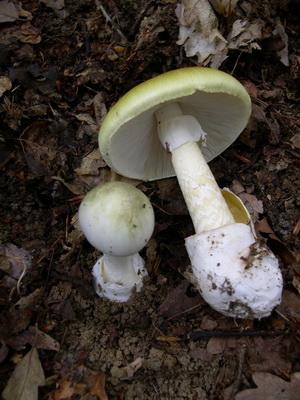

The description and photo of the field mushroom are similar to the description and photo of the pale toadstool (Amanita phalloides) and the yellow-skinned mushroom (Agaricus xanthodermus).
However, the toadstool has no aniseed scent and has a single-layer ring on the stem. And the yellow-skinned champignon has a strong medicinal smell of carbolic acid.
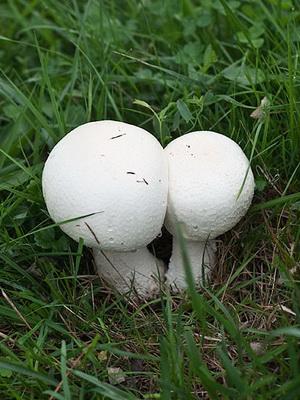
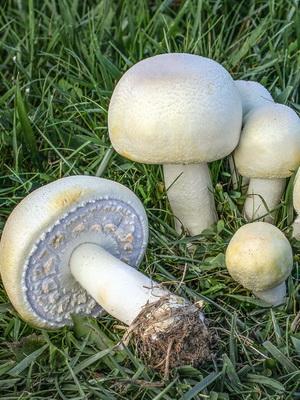
Field mushrooms grow from late May to early November in the northern regions of Russia.


Where it can be found: In open areas of forests, fields and pastures, it can be found in mountainous areas, nettle thickets or near fir trees. Large groups of field mushrooms sometimes form "witch's rings".
Eating: both fresh and after any kind of processing. A very tasty mushroom, in many countries it is considered a delicacy.
Application in traditional medicine (data have not been confirmed and have not undergone clinical trials!): In the form of an extract as an effective remedy in the treatment of diabetes mellitus. Broths have been used since ancient times in the outback as an antidote for snake bites.
Important! Field mushrooms often accumulate heavy metals. Cadmium, copper and other elements in high doses can be hazardous to health
Try to pick mushrooms in an ecologically clean area.
The British call the field mushroom horse mushroom, because it often grows on horse dung.
Red Book
Are you here:
Home - Plants of the Red Data Book of the Republic of Crimea - Bernard's Champignon (Red Data Book of Crimea)
Bernard champignon (Red Book of Crimea)
Agaricus bernardii Quél. Taxonomic position The order is agaric (Agaricales). Agaric family (Agaricaceae). Conservation status A species that is declining in numbers (2).
Area
Europe, including the British Isles, Asia (Transcaucasia, Uzbekistan, Turkmenistan, China, Mongolia), Africa (Algeria, Morocco), New Zealand.
Features of morphology
The fruiting bodies consist of a cap and a stem. The cap is 5–15 (20) cm in diameter, hemispherical, convex-outstretched, whitish, grayish or yellowish-brownish, covered with large tiled fibrous scales. The hymenophore is lamellar. The blades are loose, wide, frequent, light or pinkish-grayish, later dark brown to black-brown with a light margin. Stem 5–7 × 1.5–2.5 (3) cm, dense, cylindrical or narrowed towards the base, whitish, grayish-brownish, smooth, sometimes with a flocculent bloom at the base, with a narrow whitish unstable ring. The flesh is dense, whitish, slightly colored on the cut: above the plates in a reddish color, at the base of the leg - in reddish-ocher.
Features of biology
Humus saprotroph. Grows in the petrophytic coastal steppe. April May. Typical for steppe and semi-desert zones, it tolerates soil salinity well.
Threat Factors
Economic activities leading to the destruction of natural ecotopes (plowing virgin steppes, uncontrolled grazing), excessive recreational loads.
Security measures
Protected in the landscape and recreational park "Fox Bay - Echki-Dag". Control over the state of populations and collection, identification of new locations is necessary.
Sources of information
Wasser, 1980; Sarkina, 2012, 2013 a.
Compiled by: Sarkina I.S., Kraynyuk E.S.
Photo: Sarkina I.S., Fateryga A.V.
|
06.01.2018 12:22:42
-
Menu
- home
- Photo gallery
-
Animals
- Mammals
- Birds
- Fishes
- Amphibians
- Reptiles
- Insects
- Crustaceans
- Worms
- Molluscs
-
Plants
- Angiosperms
- Gymnosperms
- Ferns
- Mosses
- Seaweed
- Lichens
- Mushrooms
- Moscow
-
Moscow region
- Mammals
- Birds
- Invertebrates
- Pisces, presm., Terrestrial.
- Plants
- Mushrooms, mosses, lichens
-
Voronezh region
- Plants
- Animals
-
Republic of Crimea
- Plants
- Animals
-
Rostov region
- Plants
- Animals
-
Krasnodar Territory
- Plants
- Animals
-
Leningrad region
- Plants
- Animals
-
Pskov region
- Plants
- Animals
-
Sverdlovsk region
- Plants
- Animals
-
Saratov region
- Mushrooms
- Bryophytes
- Ferns
- Amur region
- Krasnoyarsk Territory
- Belgorod region
-
Chelyabinsk region
- Plants
- Animals
-
IUCN Red List
- Extinct mammals
- Rare birds of the world
- Cetaceans
- Carnivores
- Reserves of Russia
- Wild animals
- Birds of Russia
- Download the Red Book
- Basic documents
- Custom sog.
- .
Bernard's champignon
Bernard's champignon (lat. Agaricus bernardii)
This is a rare type of champignon, belongs to the mushrooms that have a limited range of their growth. There is another name for this mushroom - steppe. Most recently, it was discovered in the steppes of Mongolia, but its main location is in the deserts and semi-deserts of Central Asia. Grows in desert soils covered with a thick, dense crust. But this does not prevent him from breaking through to the light. It is also found on highly saline soils. It grows, as a rule, in groups. It is very similar to the common champignon. It features an unstable double ring on the stem and a more scaly cap.
Bernada champignon hat is spherical. Reaches 6-8cm in diameter (up to 10-12cm). The color range ranges from white to off-white with a pink or brownish tint. Over time, the cap becomes prostrate or convex. The flesh of the cap is thick, soft and fleshy.
The plates are freely located under the head. At an early age, they are pink, eventually dirty pink, then they acquire a brownish tint and finally turn dark brown.
The leg of this mushroom has an unstable thin ring on itself. As a rule, the color of the cap and the legs are the same. It reaches a height of 4-6 cm, sometimes 8-9 cm. Inside it is dense, fleshy. Delicate. The pulp is pleasant to the taste and smell. When cut, it is white, over time it begins to turn pink.
This type of champignon is suitable for eating in any form.
Bernard's champignon (lat.Agaricus bernardii)

Champignons are the most popular and popular mushrooms, both in our country and abroad, but few people know that the culture is represented by several varieties. Various representatives of the famous mushrooms are found in forests around the world, and are even grown on an industrial scale. Consider the existing types and varieties of champignons, discussing whether all the fruits of the family in question are edible.

